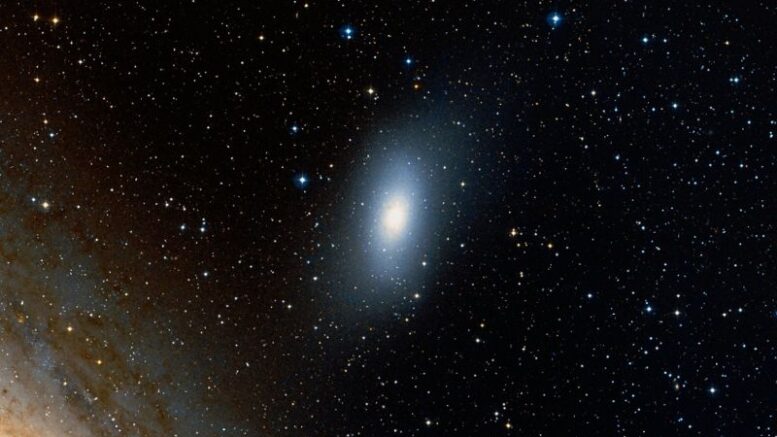Messier 110 is a dwarf elliptical galaxy that is a satellite of the Andromeda Galaxy. Although Charles Messier never included the galaxy in his list, it was depicted by him, together with M32, on a drawing of the Andromeda Galaxy; a label on the drawing indicates that Messier first observed NGC 205 on August 10, 1773. Being a satellite of the Andromeda Galaxy is how this object is such a popular imaging target.
| Description | |
| Visible From Pacific Northwest | August To December |
| Best Time To Observe | November |
| Minimum Size Of Viewing Device | Medium Sized Telescope |
| Object Type | Dwarf Elliptical Galaxy |
| Designations | Messier 110, M110, NGC 205, PGC 2429, UGC 426, IRAS 00376+4124, ISOSS J00403+4140, 2MASX J00402207+4141070, MCG+07-02-014, UZC J004022.0+414107, Z 535-14, Z 0037.6+4125 |
| Right Ascension | 00h 40m 22.1s |
| Declination | +41°41’07” |
| Constellation | Andromeda |
| Number of stars | 10 billion |
| Apparent magnitude | +8.92 |
| Apparent dimensions | 21′.9 x 11′.0 |
| Object Radius | 8,500 light years |
| Distance From Earth | 2,690,000 light years |
History
Charles Messier never added M110 to his catalogue, but he depicted both this object and M32 on a drawing of M31, the “Great Andromeda Nebula.” He first observed M110 on August 10, 1773 and noted:
Caroline Herschel discovered M110 independently on August 27, 1783 and added it as No. 9 to her catalogue. She wrote:
Augt 27th [1783]. About 1/2 deg preceding & a little north of Mess 31st a nebula. There are many stars besides in the field, but these two [diagram] are the largest.
Her brother William Herschel catalogued the object as H V.18 on October 5, 1784, describing it as “very bright, much extended, 30′ long, 12′ broad.”
John Herschel catalogued M110 as h 44 and later included it in his General Catalogue as GC 105. He described the object as “very bright; very large; much extended in position angle 165 deg; very gradually very much brighter toward the middle.”
Locating M110 In The Sky
Messier 110 is easy to find as it lies next to the Andromeda Galaxy, which can be found 8 degrees northwest of Mirach, Beta Andromedae. Mirach, a red giant with a visual magnitude of 2.05, is the middle of the three bright stars of Andromeda (Alpheratz, Mirach and Almach) that form a straight line from the Great Square of Pegasus (formed by Alpheratz, Scheat, Markab and Algenib) in the direction of Perseus, under Cassiopeia‘s W asterism.

M110 Star Chart Location. Image Credit: Roberto Mura
Viewing M110
To be seen in small telescopes, it requires exceptionally clear, dark skies. In 3-inch telescopes, M110 appears as a faint, diffuse patch of light, while 8-inch telescopes reveal a larger oval shape with a slightly brighter core.
Photographing M110
Messier 110 is actually quite a popular target for astrophotographers because of it being a satellite galaxy of Messier 31, the Andromeda Galaxy, which is a very popular target.
Therefore, when imaging M110, use make sure to follow guides for photographing Messier 31, the Andromeda Galaxy as capturing M31 will capture M110 with a wide enough image. There are many ways to capture M31 and M110, from using a CMOS and auto guiding scope to an unmodified DSLR and tracking. As such, there are a plethora of available options.
This includes using a DSLR for 2 second exposures, ISO 200 at f/2.0 for a photo that resembles M31 and M110 as a basic starting point to using a 6 inch telescope to get the entire area in the scope with 5.5 hours of exposure using a CMOS camera for a detailed view. It is definitely possible for everyone a specific skill level to photography M110.
Sources And Future Reading
Descriptions of all of Messier Objects can be found here.
https://www.nasa.gov/feature/goddard/2018/messier-110
https://freestarcharts.com/messier-110
https://www.galactic-hunter.com/post/m31-the-andromeda-galaxy

Be the first to comment on "Messier 110"